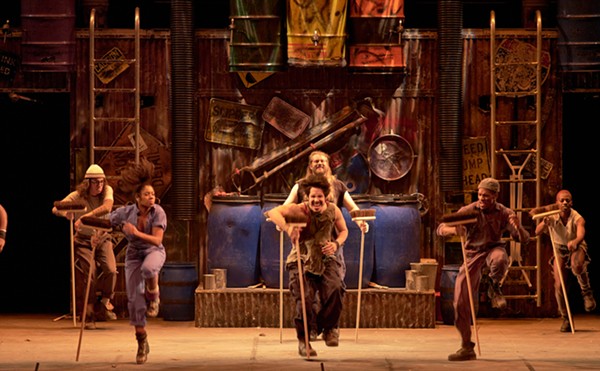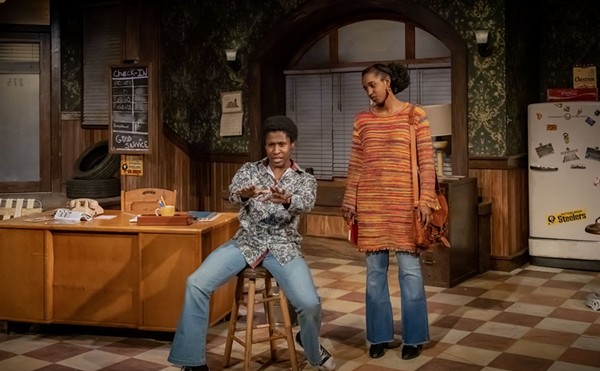"A lot of people try to catch me when I say I'm very lucky," says Parma-born painter Frank Oriti, Jr., who has made a full-time job of making art. He also snagged a Cleveland Arts Prize and been featured in The New York Times, all in the last six months.
His recent success grows out of his still-growing series that features traditional, richly detailed portraits of hometown friends struggling to stay upright in an economy tilted against them, their frustrations visible on their faces.
The subject matter carries a lot of pathos these days, but Oriti's studied execution has distinguished him from innumerable other Midwest creators exploring proletarian discontent.
Still, Oriti still seems taken aback by how much has gone right.
"I do work hard in the studio, I'm a big believer in the idea that hard work makes improvement. But I've definitely been lucky in how timing has worked out," Oriti says.
Oriti's parents recognized his talents early on, and helped him through art classes, and eventually undergraduate studies at Kent State, Tri-C, and Bowling Green State University. After securing his bachelor's, he moved back home to Parma and started work in a steel mill, often putting in 12-hour shifts.
After racking up that time, socializing was a better way to keep his sanity than painting. His artistic output trickled.
The length, strain, and boredom of that work drove Oriti to save up for graduate studies at Ohio University, but he also found support from the men he worked alongside.
"They would look out for me. When they heard I'd already been to college, they'd tell me to go back," Oriti says.
He would go back, and the experience would clarify both the content of his projects and his own understanding of his approach to art.
Heading to OU, Oriti knew he wanted his art to speak up in conversations about the state of the working class. However, he says he spent time "floundering" in grad school figuring out just what he wanted to say, and how. He tried painting roughed-up clothes to bring to life the sweat and grease of manual labor. Despite his affinity for painting denim, Oriti says he got bored after finishing a few canvases.
Afterwards, he turned his attention to something possibly even more intimate than his laundry. Over his post-undergraduate years, he had noticed he wasn't the only one of his peers still in Parma, living with his folks, working somewhere he hadn't expected he would.
It was these people he chose to paint. Oriti's models' backgrounds are modest; many come to his studio in jeans and T-shirts which bare the tattoos running down their arms. But the style they are rendered in is regal, filling large-scale canvases with oils and acrylics applied with fine enough detail to bring to life the grain of stubble, the weave of fabrics, and the subtleties of bemusedness or defensiveness which shade faces.
Oriti's figures stand against stark white backgrounds. Sometimes, the outlines of houses bleed into visibility. These ghostly homes represent the domestic security that has eluded many of the aritst's peers.
At the inception of his project, Oriti worried the struggling strivers he approached would be offended essentially being singled out as individuals having especially hard times getting careers started. However, he found his friends receptive.
"I was really afraid they would think I was talking down about their situation and that they were disappointments. But I did the same thing. I went off to college and came back to the house I grew up in. They're as much self-portraits as they are paintings of other people," Oriti says.
Furthermore, the images' meticulous style conveys Oriti's care for his subjects.
"A lot of time, detail and attention go into these paintings. What better way of celebrating someone is there than painting their portrait?" Oriti says.
Oriti interprets his technique through his time in manufacturing. He talks about himself as a "technician," and credits the long, repetitive days of shift work as one source of the meticulousness which defines his portraits.
Oriti builds his images up slowly. He starts sketching with photos snapped by his studio-mate, Peter Larson. He sets down a uniform skin tone, and then builds up layers and layers of detail. He can take anywhere from six weeks to three months to finish one painting (though this time is stretched out by the proverbial waiting for paint to dry).
"I apply a blue-collar work ethic to my painting," Oriti says. "I'm not saying I'm the last of a dying breed, but a lot of people see what this entails and want no part of it."












